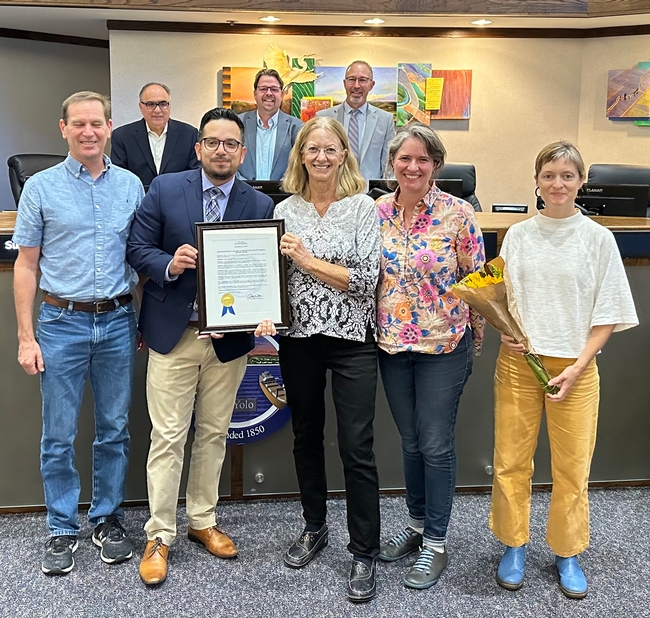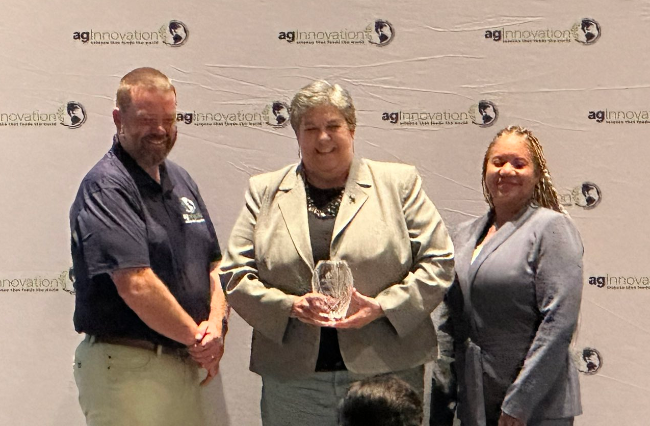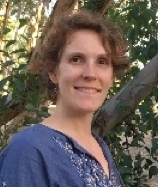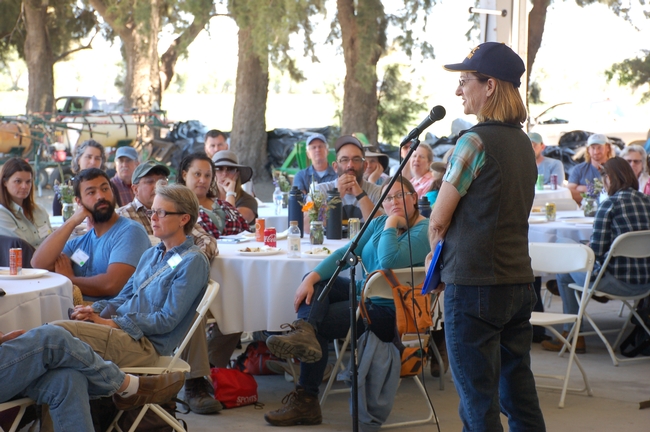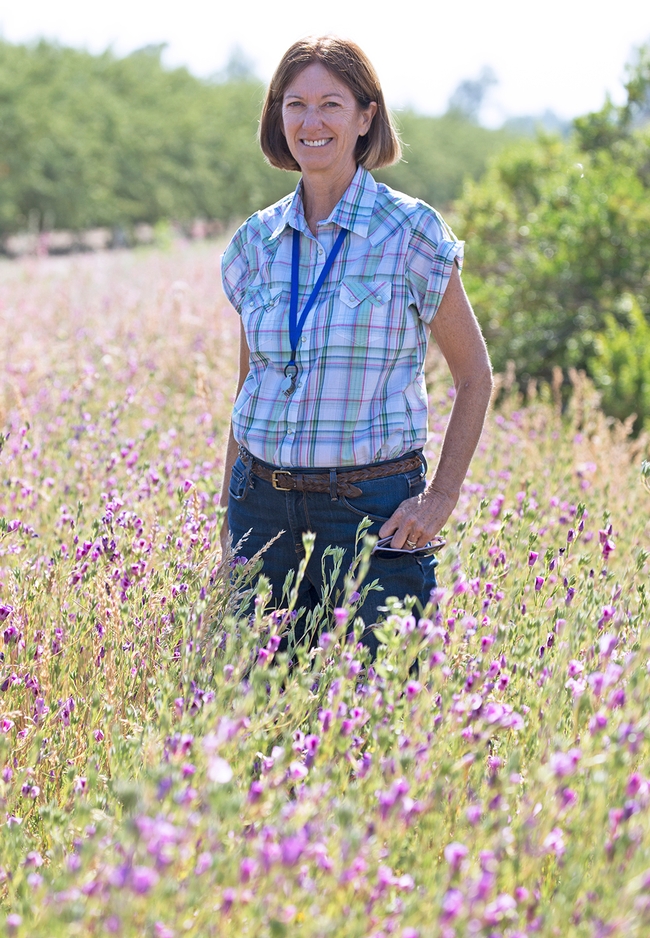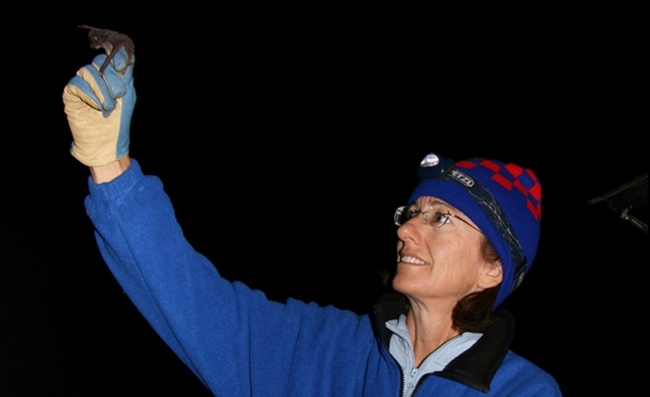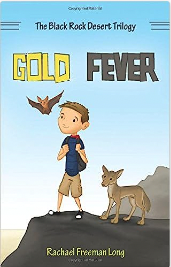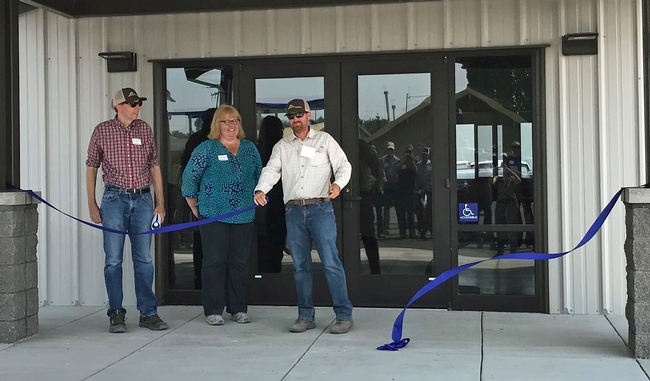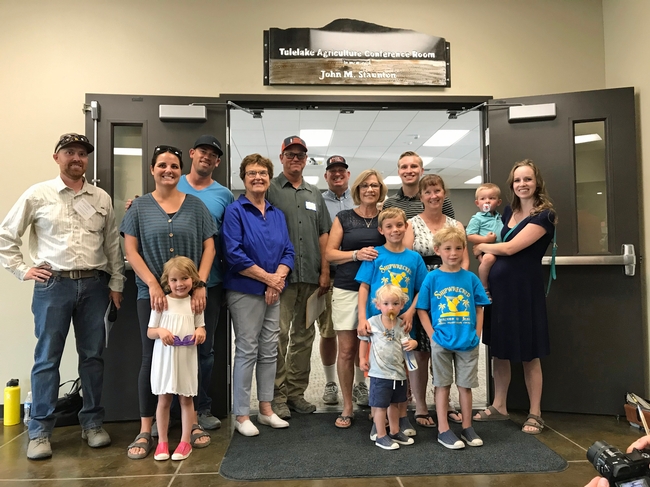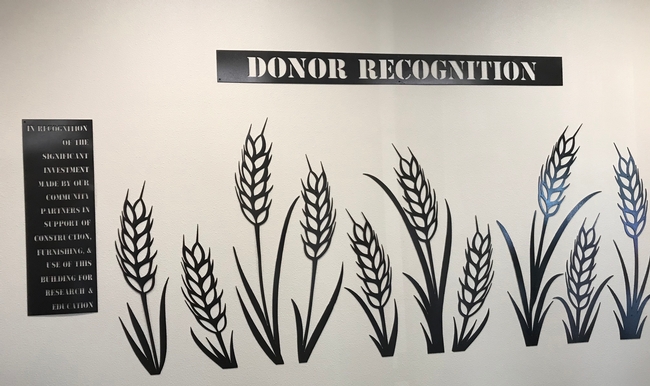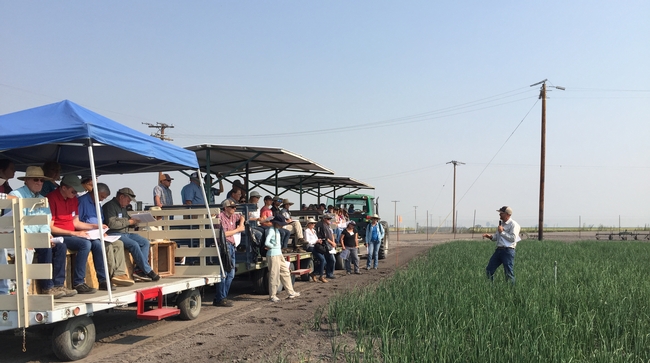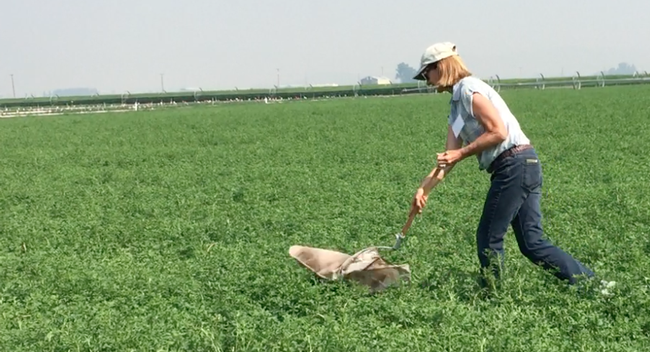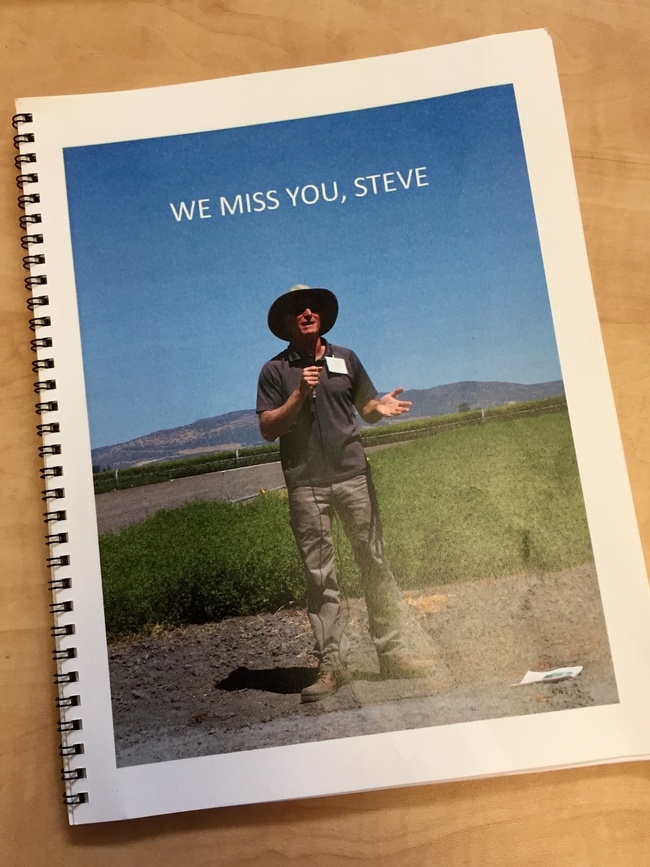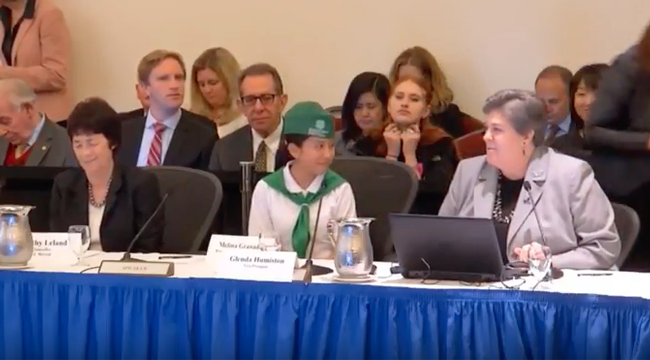Posts Tagged: Rachael Long
Celebration Corner
Editor's note: This new monthly feature provides an opportunity to recognize UC ANR colleagues and teams. Send your shout-outs to contentpipeline@ucanr.edu.
Long honored by Yolo County supervisors
Yolo County Supervisor Angel Barajas presented Rachael Long, emeritus UC Cooperative Extension farm advisor, with a resolution recognizing the valuable research she has contributed to Yolo County farmers over her 37-year UC ANR career. Supervisors Jim Provenza, Lucas Frerichs and Oscar Villegas joined Barajas in thanking Long for her service. Susan Ellsworth, UCCE Capitol Corridor director, and UCCE advisors Morgan Doran and Margaret Lloyd attended the ceremony on Sept. 26.
Read about Long's career at https://bit.ly/3rkowlR.
Humiston receives Excellence in Leadership Award
Vice President Glenda Humiston was honored with the 2023 Experiment Station Section Excellence in Leadership Award for the Western Region. The award is presented to leaders who personify the highest level of excellence by enhancing the cause and performance of the regional associations and ESS in achieving their missions and the Land-Grant ideal.
The award, which was announced in April, was presented to Humiston on Sept. 26 at the Ag Innovation Annual Conference in Grand Rapids, Michigan.
FIRA attracts more than 2,000 participants
UC ANR Chief Innovation Officer Gabe Youtsey and the team at The VINE did a phenomenal job partnering with Western Growers and Global Organization for Agricultural Robotics (GOFAR) to organize the second annual FIRA USA. More than 2,000 people attended the three-day event in Salinas.
ANR celebrates Hispanic Heritage Month
Kudos to the Latinos and Friends Affinity Group for organizing three fantastic virtual events for Hispanic Heritage Month. Ricardo Vela, Miguel Sanchez, Arianna Nava, Doralicia Garay, Angela Johnson, Adela Contreras and Lisa Rawleigh put together these wonderful learning opportunities that are recorded and available at http://ucanr.edu/hhm2023.
Nobua-Behrmann to discuss shothole borers on KLCS
Bea Nobua-Behrmann, UC Cooperative Extension urban forestry and natural resources advisor for Los Angeles County, will be on an episode of Things Green with Nick Federoff. Nobua-Behrmann will talk about shothole borers and not moving firewood to prevent the spread of the pests. Her segment on the half-hour sustainable lifestyle show with a heavy emphasis on home, garden, ag, ranching and farming is scheduled to air on Oct. 21. You can watch it at 9 a.m. on Saturday on KLCS-TV 58 or see the simulcasts on Facebook and YouTube.
Rachael Long retires as UCCE farm advisor after 37 years
Rachael Freeman Long grew up in Berkeley but was fascinated by farming. The UC Cooperative Extension farm advisor has spent the past 37 years doing research on crop production, pollination and pest control and collaborating with farmers.
Long worked with UCCE in Sonoma and San Joaquin counties as well as at UC Berkeley, before settling in Yolo County as a farm advisor in 1992. She has focused on field crops including alfalfa hay and other forages, dry beans, and hybrid seed crops such as sunflowers, melons and onions.
She plans to retire July 1 after serving growers in Yolo, Solano and Sacramento counties for 31 years.
Long's pest management studies highly influential
To produce practical research results, Long has collaborated on studies with the Hrdys and many other growers over the years. Her field studies informed the sunflower, alfalfa, onion seed and dry bean production manuals that she co-authored with UC ANR colleagues.
Cost-of-production reports on alfalfa, sunflowers, lima beans, common beans and garbanzo beans that she co-authored have been used by growers for obtaining farm loans. Since 2014, her cost studies have been used over 50,000 times.
Long's research and extension of integrated pest management practices have resulted in enhanced biodiversity, reduced pesticide use, higher crop yields, healthy soils and carbon sequestration, and greater farm productivity and profitability. Her research papers have been cited by scientists over 1,200 times. She was the recipient of the Bradford Rominger Agricultural Sustainability Leadership Award in 2019.
Adoption of new farming practices
Her work in the late 1990s documented how pesticides were transported offsite from farm fields in surface irrigation water. At the time, the agricultural industry was concerned the results would prompt increased regulations and restrictions on farming practices. But she persisted and her research led to the development and adoption of practices – such as pesticide choice and vegetative filter strips including cover crops – that are now commonly used to protect surface waters from pesticides used on farms.
“I'm proud of my community and appreciate the opportunity to work with farmers and the privilege of conducting research on farms,” Long said. “I'll forever be grateful to landowners for their support of my projects, even ones that seemed so far out there, like studying bats and pest control in walnut orchards!”
Her research has shown that bats, as well as insectivorous birds, help control insect pests on farms, which helps growers reduce their reliance on pesticides.
As scientists look for ways to slow climate change, one of Long's recent studies revealed that hedgerows sequester 36% more carbon than farmed areas.
“I loved working with students and postdocs on hedgerows,” she said. “We found that field edge plantings of native plants provide floral resources for natural enemies and bees that move into adjacent crops for enhanced pollination and pest control services in adjacent crops, reducing pesticide use and boosting yields. I'm proud that many have gone on to pursue careers in agriculture and natural resource conservation.”
Hedgerows become conservation practice
Mary Kimball, CEO of the Center for Land-Based Learning in Woodland, was Long's field assistant in 1996. Kimball, who worked for the Yolo Resource Conservation District, was the project manager for the first hedgerow project that Long led.
“Over the years, Rachael has strategically and methodically tackled every question, concern and potential barrier for on-farm hedgerow installation – not only disproving all of the myths about pests, but showing the dramatic importance of these native plant hedgerows to everything from wildlife habitat, insectary value, use by bird species, and most recently, carbon sequestration,” Kimball said.
“As a result, hedgerows are now by far the most applied-for conservation practice by farmers and landowners through USDA Natural Resources Conservation Service cost-sharing programs across the state,” Kimball added. “Her impact and the way that she went about doing this research – in collaboration and with all needs and concerns of the farmer in mind – show us how to tackle new ideas and ensure their sustainability over time.”
Lifelong interest in agriculture evolves with technology
The daughter of a UC Berkeley biology professor and graduate of UC Berkeley with a B.S. in biology and UC Davis with an M.S. in entomology, Long always had an interest in wildlife, conservation and exploring the natural world.
“I've always been interested in agriculture, probably from spending summers as a kid with family in Sonoma County,” she said. “However, what totally sparked my interest in crop production was hearing a farm advisor talk about integrated pest management when I was in college. I found that so inspiring that I changed my major from pre-med to agriculture, a great decision, not only for my career, but I met my husband through work and we currently live and farm here in the Woodland area.”
Since her start in 1986, technology has changed rapidly. Calling it “challenging and exciting,” Long said, “I'm proud of the opportunity to work with farmers to learn about global positioning systems, subsurface drip and healthy soils practices that were so helpful in my research and outreach programs.”
As a mother and a scientist, Long is committed to piquing children's interest in science. She has published three children's books chronicling a boy's adventures with wildlife, based on stories she told her own son, Eugene. Long recently published “See You Later Alligator,” an online children's book.
In retirement, Long is looking forward to having more time to write kids' books focusing on science literacy and “sharing more about how to respect and live with wildlife for everyone's safety – animals and people.”
“Next is a high adventure story that brings kids into a world of bees!” Long said. “I'm super excited with this ArcGIS storymap format to share online with kids! It's a great teaching opportunity maps, illustrations, and a storyline, along with discussion questions to engage kids!” Long and colleagues recently created a storymap on Native Bees.
Long, who received prestigious emeritus status from UC Agriculture and Natural Resources, will also finish up some research projects.
Intermountain REC brings state-of-the-art conferencing to Tulelake
Intermountain Research and Extension Center (IREC) celebrated the grand opening of a multipurpose conference and laboratory building on July 26. The facility will be available for use by private and public groups for business meetings, job fairs, trainings and conferences.
"The facility is the first in the Tulelake area to offer modern audio-visual infrastructure and high-speed internet connectivity capable of supporting remote presentations to stay in touch with groups from around the world," said Rob Wilson, IREC director. "We hope this facility will greatly increase the visibility and accessibility of local events and help draw more regional attention to the area."
The conference room was dedicated in honor of the late John Staunton, a local research collaborator with UC Agriculture and Natural Resources who passed away in 2015. Staunton Farms and the Staunton family donated $25,000 to support the building project and recognize the Tulelake farmer and his long-standing support of agriculture and research.
Winema Elevators/Western Milling, Sensient Natural Ingredients, Macy's Flying Service, and Basin Fertilizer also contributed support.
UC awarded approximately $2 million for this capital improvement project with funds from UC lease revenue bonds to pay for most of the building's design and construction costs, but additional support is needed to complete the project. Intermountain REC has set a fundraising goal of $100,000 to pay for tables, chairs, furnishing and lab equipment for the building.
A special UC fund has been created to collect tax-deductible contributions to be used solely for this building project. Donations over $50 will receive recognition in print and on the IREC website. Donations over $1,000 will receive recognition on the donor wall in the building entryway. Name plate recognition on the donor wall will be based on the gift amount: Gold ($2,500+), Silver ($1,750 to $2,499), and Bronze ($1,000 to $1,749). Donations can be made via check using the enclosed envelope or by credit card by visiting the IREC website at http://irec.ucanr.edu and clicking the “Make a gift” link.
The ribbon cutting followed the 2018 IREC field day, an annual event that showcases the research underway at the 140-acre facility. Charlie Pickett of USDA, UC Davis Plant Breeding Center director Charlie Brummer, UCCE farm advisors David Lile and Rachael Long and UCCE specialist Dan Putnam joined Wilson in giving research updates on the tour.
Research presentations included work on biological control of cereal leaf beetle, influence of fall harvest management of irrigated grass hays, onion white rot, managing alfalfa weevil and clover rootcucurlio, pulse crop options for theKlamath Basin, cover crops and amendments, cutting schedule effects on lowlignin alfalfa andgermplasm evaluation of alfalfa and tallfescue.
Reporter Danielle Jester, who covered the events for the Siskiyou Daily News, noted the palpable absence of the late Steve Orloff, who was a UCCE farm advisor for Siskiyou County for 25 years. “Orloff's absence was noticeably felt throughout the day,” she wrote. “He passed away in October of 2017, and his influence in Siskiyou County's ag industry was very apparent, evidenced in part by the many mentions of his name and work throughout the day. IREC paid tribute to Orloff in the final page of its field day guide, which featured a full-page image of Orloff during a previous field day, with the words, ‘We miss you, Steve.'”
In the news article, Jester also wrote, “The information gleaned through research at the IREC can be invaluable to farmers and other researchers. Through its years of experimentation, the center has helped growers develop more effective practices in a wide range of areas, from determining the crops that will grow best in the local climate, to selecting the most economically viable crops for the region, to understanding the most effective ways to manage pests and disease.”
UC Merced chancellor, 4-H’er and VP discuss community outreach with regents
UC VP Glenda Humiston, 4-H member Melina Granados of Riverside County and UC Merced Chancellor Dorothy Leland gave the UC regents a presentation about UC ANR's community outreach and impact. The Public Engagement & Development Committee meeting was held at the UCSF–Mission Bay Conference Center on Jan. 24, 2018, in San Francisco.
Opening the discussion, Humiston gave an overview of ANR, explaining that for 150 years ANR has been bringing the power of UC directly to the people in all California counties. Melina, who was born in Mexico, talked about her role as president of the Eastside Eagles 4-H club and what she has learned. Leland described joint projects between UC Merced and ANR in climate adaptation, nutrition and drone technology research.
Watch the 25-minute recording of the UC ANR presentation to the regents below, or visit https://youtu.be/ptFS8HwlsjE.
AI can help growers more precisely manage their fields, Humiston tells Little Hoover Commission
Artificial intelligence, or AI, can improve precision agriculture by using sensed environmental data to “learn” and continually adapt, VP Glenda Humiston told the Little Hoover Commission at a hearing in Sacramento on Jan. 25.
The Little Hoover Commission is reviewing the impacts of artificial intelligence. While there is no singular definition, artificial intelligence encompasses a broad range of technologies that seek to approximate some aspect of human intelligence or behavior.
Throughout its study, the commission will consider the potential policy role of California state government in areas such as regulation, workforce development and retraining.
Humiston was asked to give a statement on the impacts of artificial intelligence in the agricultural sector.
“California's working landscapes face some critical challenges; among those are drought, climate change, air quality, soil health, pests, pathogens and invasive species,” she said. “Additionally, rural/urban conflicts and urban sprawl continue to reduce available farm land and make viability of food production more difficult.
“Of importance to today's hearing, California's labor-intensive crops are facing increasing difficulty accessing necessary labor – both skilled and unskilled. This situation has led growers and universities to seek solutions through mechanization, automation and other new technologies.”
She sees opportunities in precision agriculture for growers and ranchers to more precisely manage their operations by using site- and crop-specific data gathered by new technologies.
“Artificial intelligence improves this further by using the sensed environmental data to ‘learn' and continually adapt to ever-changing conditions as it receives data that strengthens the computer's ‘intelligence,'” she said.
Humiston also outlined some of the challenges to harnessing the power of AI for agriculture.
“Artificial intelligence is extremely difficult in agriculture because of the huge amount of variability in environmental conditions across a single field,” she said. “This requires many sensors, complex algorithms, and large real-time data processing – all integrated and working together to inform decisions and actions.”
In a 2014 Pew Research Center survey, the vast majority of the 1,896 experts anticipated that robotics and artificial intelligence will “permeate wide segments of daily life by 2025.” The commission's artificial intelligence project will investigate the shape and speed of these changes in California and in society.
Through its public process, the commission intends to study the key challenges of artificial intelligence in California, its economic implications and how it can be used to solve societal ills. The commission will review issues such as justice, equity, safety and privacy. The project will consider recent studies on workforce impacts, which could include both job creation and job displacement. Possible mitigations and worker protections will be discussed as will examples of efforts to plan and prepare for innovations and labor transformations.
To read Humiston's full testimony to the Little Hoover Commission, visit http://www.lhc.ca.gov/sites/lhc.ca.gov/files/CurrentStudies/ArtificialIntelligence/WrittenTestimony/HumistonJan2018.pdf.

